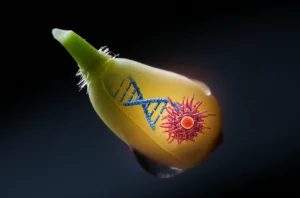When Fish Grow Up: Unpacking the Diet Secrets of Native and Invasive River Predators
Hey there! Let me tell you about something fascinating happening beneath the surface of our rivers. You know how sometimes new species show up in places they weren’t originally from? Especially big, impressive fish introduced for sport fishing? Well, while that might sound fun for anglers, it gets scientists like me wondering: what happens when these newcomers are top predators, sharing the water with the native big fish? It’s like introducing a new heavyweight boxer into a ring already occupied by a champion.
The Fishy Business of Growing Up
So, the stars of our story today are two cool fish: the native Northern Pike (*Esox lucius*) and the non-native Pikeperch (*Sander lucioperca*). Both are what we call “piscivores,” which is just a fancy way of saying they eat other fish. But here’s the kicker: they don’t start out eating fish. When they’re young, they munch on smaller stuff, like macro-invertebrates (think aquatic insects and critters). As they grow bigger, they switch their diet to fish. This change is called an *ontogenetic dietary shift*, and it’s a super important part of their life story. It affects how fast they grow, where they hang out, and who they interact with.
Now, when you have two species that both eat fish and live in the same place, you might expect them to be constantly competing for the same meals. This is especially true if they’re in the same “functional guild,” meaning they do similar jobs in the ecosystem (like being top fish predators). That’s exactly the situation with pike and pikeperch in some English rivers, where pikeperch were introduced decades ago.
Diving into the Study
I got curious about how these two species manage to co-exist, especially considering that crucial diet switch they both make. Does the invasive pikeperch muscle in on the native pike’s food supply? Or do they find ways to share the buffet? To figure this out, researchers (including some whose work I’m drawing from here) looked at populations of pike and pikeperch in the lower Severn River Basin in Western England.
They used a cool technique called *stable isotope analysis* (SIA). Think of stable isotopes (specifically δ15N and δ13C in this case) as tiny chemical signatures in an animal’s tissues (like scales or muscle) that reflect what it’s been eating over time. δ15N gives us clues about an animal’s trophic position (how high up the food chain it is), and δ13C can tell us about the source of their food (like whether it came from near the shore or open water, or even marine-derived nutrients if they eat migratory prey). By looking at these isotopes in fish of different sizes, we can see when and how their diet changes. For the pikeperch, they also checked stomach contents, which gives a snapshot of their *very* recent meals.
The main goals were:
- Find out at what size each species switches to eating fish.
- See how this diet switch changes their “trophic niche” (basically, their place in the food web and the variety of resources they use).
- Assess how much their food spaces overlap, both before and after they become full-time fish eaters.
They sampled fish from three different spots, including boat marinas which are important hangouts for young fish. They used seine netting in the marinas and relied on dedicated anglers for samples from the main river channels (catch-and-release for pike, thankfully!). Using scales for SIA on the pike was a neat trick, as it’s non-destructive for those catch-and-release fisheries.

What the Isotopes and Stomachs Revealed
Okay, here’s the juicy part – the findings!
First off, the diet switch timing: Turns out, the pikeperch generally start eating fish at smaller body sizes than the pike. While there was a good bit of *individual variability* (some fish switched earlier or later than others within the same species), the overall trend was clear. Pikeperch were found to be eating fish from as small as 31 mm! Their trophic position (that δ15N signature) started showing the shift to higher levels (eating fish) when they were between 30-70 mm. For pike, the shift in trophic position happened at larger sizes, typically between 100-200 mm. Both species are making this big change within their first year of life, which is pretty common for these kinds of predators.
The stomach contents analysis for the smaller pikeperch backed this up, showing fish becoming a dominant part of their diet at relatively small sizes, although macro-invertebrates were still on the menu for some individuals up to about 150 mm.
Now, about their “food space” or isotopic niche: This is where it gets really interesting. Despite both species ending up as fish-eaters, their isotopic niches showed *low overlap* overall. The pike’s niche tended to be more enriched in δ13C, suggesting they might be getting energy from slightly different sources or habitats compared to the pikeperch. The δ15N values (trophic position) were quite similar between the species when looking at the whole population, but there were differences depending on size and location.
Niche Dynamics and Diet Switches
The study also looked at how the *size* and *position* of their food niches changed as they went through that diet switch.
Before they fully switched to piscivory (eating mostly fish), the pikeperch actually had a larger isotopic niche than the pike at one of the sites where this could be properly compared. This suggests the young pikeperch were perhaps more varied in their macro-invertebrate diet or using a wider range of food sources initially.
After both species made the switch to being primarily fish-eaters, their niche sizes became more similar, and the overlap between their niches increased slightly, but it was still relatively low overall.
Here’s a key finding about the switch itself: For pike, switching to piscivory led to a *significant expansion* of their isotopic niche. It’s like once they could eat fish, a whole new world of food opened up, and they started using a broader range of resources or habitats reflected in their isotopes. For pikeperch, this niche expansion after switching wasn’t observed in the same way.

Individual Variability and Why it Matters
Remember that *individual variability* I mentioned? It’s a big deal! Even within the same size group, some individual fish had quite different trophic positions. This is especially true for the smaller pikeperch. This variability can mean that not all fish of the same size are eating the same thing, which could lead to some individuals growing faster (the ones who switch to fish early) than others (who stick to invertebrates longer). This kind of within-species variation is important for how populations function.
Why might their niches be different even when they both eat fish? One big reason could be their morphology, especially their *gape size* (how wide they can open their mouths). Pike are known for having larger gapes than pikeperch of the same length, which means pike can eat larger prey fish. This difference in potential prey size could be a major factor in why their diets, and thus their isotopic niches, remain somewhat separate even when both are piscivorous. It’s not just *eating fish*, it’s *eating different kinds or sizes of fish*.
So, What Does This Mean for the River?
This study gives us some valuable insights into the ecological consequences of invasive pikeperch. Instead of directly competing head-to-head with native pike for the *exact* same food items at the *exact* same life stage, it seems the pikeperch are largely exploiting a *different* part of the prey community.
The fact that pikeperch switch to eating fish at smaller sizes means they start preying on fish that are too small for young pike to eat. And even when they are both large piscivores, differences in gape size and potentially habitat use or prey preferences (reflected in the isotopic niches) suggest they are often targeting different parts of the fish population.

The overall picture is that the invasive pikeperch are increasing the total predation pressure on the fish community in these rivers, but perhaps not primarily by eating the same fish that pike would otherwise eat. They’re adding pressure on prey resources that the native pike don’t typically use, or at least not to the same extent or at the same life stage.
While there have been concerns about pikeperch impacting native fish populations, this study suggests that the impact might be more about broadening the range of prey being eaten in the system rather than intense competition for the same limited resource pool. The native fish populations like roach and bream in these rivers seem to be sustaining both species and supporting recreational fisheries, but we still don’t know for sure what their status would be if the pikeperch weren’t there.
Wrapping Up
Understanding these subtle differences in how native and invasive predators use resources as they grow is crucial for predicting and managing the impacts of invasions. Stable isotopes proved to be a powerful tool here, showing not just *that* a diet switch happens, but *when* it happens for different individuals and how it shapes their place in the food web. While there are always limitations (like the time lag in isotopic signatures reflecting diet changes, especially in fast-growing young fish), combining methods like SIA and stomach contents helps build a clearer picture.
The key takeaway for me is that the story isn’t just about two big fish eating other fish; it’s about *how* and *when* they do it, and how those differences allow them to co-exist while fundamentally changing the overall predation dynamics in the river. It’s a complex underwater world out there!
Source: Springer







